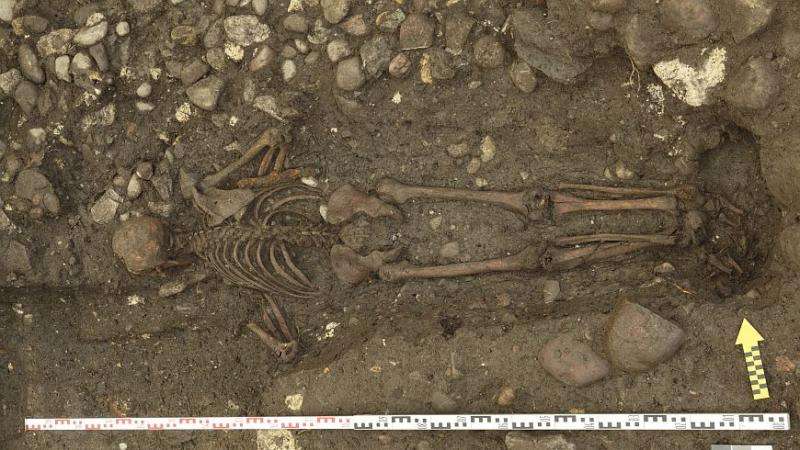
PHOTO: phys.org
BERNESE LAKELAND, SWITZERLAND – Archaeologists discovered a burial in an ancient cemetery in 2013 that is still baffling them today.
Construction workers were just starting work on an underground garage next to a churchyard wall in the Swiss village of Schüpfen when they stumbled across a pile of human bones. It gave them quite a scare, even though the contractor was aware they were working with a possibly “sensitive area”. The builders were aware the area had been used as a cemetery during the Middle Ages, and immediately contacted the state archaeological services.
In total, 342 bodies were uncovered. In the last 15, archaeologists discovered the man whose burial holds a level of mystery that is completely unique to him.
He was buried separate from the others, laid face down in his grave.
Christian Weiss, a numismatic expert with the Archaeological Services of Canton Bern remarked casually, “This is quite unusual.”
Further digging revealed that strange circumstances surrounded the man’s death. Next to his body was buried a knife and a pile of coins that had all fused together in rust. It was probably what was left of his coin purse.
Bodies in Medieval towns were usually buried lying face up, facing East, in expectation of the second coming of Christ. For a body to be buried face down is highly unusual. Why would the man be buried like this? Several theories have been posed.
Perhaps the burial had been done in a hurry, because the man had died of an infectious, contagious disease. Or, perhaps there was foul play at work. Maybe somebody had robbed and killed him and quickly buried the man facedown, hoping that nobody would find and identify him, or the soul wouldn’t come back and haunt them. Or, perhaps it was a vengeance kill, and burying the body face down was one last victory against the deceased.
Hoping to solve the mystery, the archaeologists and researchers examined the only hard evidence they had: the coins.
The coins had been buried beneath the man’s chest. The leather had decomposed, and the coins had rusted together into a solid block. Sabine Brechbühl, a specialist in restoring metallic objects with the Archaeological Service of Canton Bern was called in, but he wasn’t able to separate the block without damaging the individual coins.
When that failed, she decided to try x-raying them. Unfortunately, the thick layers yielded very little in the way of more information with conventional x-ray techniques.
So, they called in another specialist: Mathieu Plamondon, an x-ray specialist.
“The block of coins isn’t very big but it absorbs a great deal of energy, so we needed a very powerful source of x-rays,” Plamondon said.
Thanks to some new technology on the market, they had just that. Plamondon was able to use an x-ray computer tomograph.
“We didn’t know how well it would work though,” Plamondon recalled, “because it was the very first time we had made a measurement with the new instrument!”
Well, they got lucky.

PHOTO: phys.org
The x-ray with the new machine was excellent quality. Twenty four coins could be identified. Some were made from a copper-silver alloy, and one was pure silver. Plamondon was able to virtually enhance the data the machine took until the embossed images and text on the sides of each individual coin could be made out.
The latest coin dates to 1629, so the man must have been buried sometime after then.
“Taken together, the coins are really just small change,” explained Weiss. “There is nothing in the purse equivalent in value to, say, a hundred franc note today.”
He has a theory as to the man’s identity based on his coin purse.
“It is possible he was a traveling merchant, because we found coins in the purse from the Fribourg-Bern-Solothurn, Basel-Freiburg in Breisgau and Luzern-Schwyz regions.”
Since the coins in the man’s purse don’t add up to much, Weiss thinks it’s unlikely the man was killed for his money. Unfortunately, there just isn’t enough evidence to solve this particular cold case. It’s likely that the reason for the man’s death and unusual burial will probably always be a mystery.

